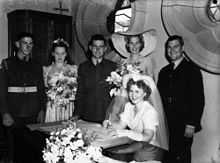Marriage in Australia


As was the case for other western countries marriage in Australia for most of the 20th century was done early and near-universally, particularly in the period after World War II to the early 1970s. Marriage at a young age was most often associated with pregnancy prior to marriage.[1]
Marriage was once seen as necessary for couples who cohabited. While such an experience for some couples did exist, mostly because it is hard to detect, it was relatively uncommon up until the 1950s in much of the western world.[2] If both partners are under the age of 18, marriage in Australia is not permitted. In ‘exceptional circumstances’ the marriage of persons under 18 but over 16 may be authorised by a court.
The official registration of marriage is the responsibility of each state and territory.[3] A Notice of Intended Marriage is required to be lodged with the chosen celebrant.[4]
According to a 2008 Relationships Australia survey love, companionship and signifying a lifelong commitment were the top reasons for marriage.[5]
History

In colonial New South Wales marriage was often an arrangement of convenience. For female convicts marriage was a way of escaping incarceration and land leases were denied to those who were unmarried.[6]
A federal Marriage Act was passed in 1961 which set uniform Australia-wide rules for recognition and solemnisation of marriages. Prior to this Act, the states and territories administered their own marriage laws. The Commonwealth Family Law Act of 1975 made it easier to divorce and removed the concept of fault, requiring only a twelve-month period of partners' separation.[7]
The 1970s saw a significant rise in the divorce rate in Australia.[1] A change in social attitudes from divorce being only acceptable if there were severe problems towards divorce being acceptable if that is the preference of the partners is attributed to this change.[8] By the 1980s the trend towards a delay of first marriage in Australia was evident. In 1989, more than one woman in five had not married by the age of 30.[1]
Australia has recognised de facto relationships since the Family Law Act of 2009.
Social change
Common-law marriage has increased significantly in recent decades but has not replaced traditional marriage in Australia. It is typically a prelude to marriage and reflects the shift to attain financial independence before having children.[9]
In 1971, more than three quarters of women surveyed placed being a mother before their career. By 1991 this figure had dropped to just one quarter.[7]
Same-sex marriage
While there have been attempts to have same-sex marriage legalised, same-sex marriage is not permitted under Australian federal law. The Marriage Amendment Act in 2004 inserted the common law definition of marriage into the Act. The definition reads:
- Marriage means the union of a man and a woman to the exclusion of all others, voluntarily entered into for life.
Same-sex couples have access to domestic partnership registries in New South Wales, Tasmania, Queensland and Victoria. Civil partnerships are performed in the Australian Capital Territory.
Those opposed to same-sex marriage have argued that:
- marriage has always been defined as a heterosexual union
- any change to the current arrangements would impact on the freedom of religion and conscience, and
- any change would, "sever the natural connection between marriage and children".[10]
They have said that children have a birth-right, wherever possible, to both a mother and father, with same-sex marriage being a calculated decision by which a child is forced to miss out on a mother or a father[11] with governments being in the marriage business, "because the union of a man and woman can produce a child and children need a mum and a dad."[12]
See also
- Australian Aboriginal kinship
- Australian family law
- Polygamy in Australia
- Voidable marriages (Australia)
- Celebrant (Australia)
References
- ↑ 1.0 1.1 1.2 McDonald, P. (1992). "The 1980s: Social and Economic Change Affecting Families". In Jagtenberg, Tom; D'Alton, Phillip. Four Dimensional Social Space. Pymble, Sydney: Harper Educational Publishers. pp. 126–128. ISBN 0063121271.
- ↑ Thornton, Arland; William G. Axinn; Yu Xie (2008). Marriage and Cohabitation. University of Chicago Press. p. 72. ISBN 0226798682. Retrieved 3 August 2013.
- ↑ "Births, deaths and marriages – Fact sheet 89". National Archives of Australia. Retrieved 3 August 2013.
- ↑ "Your Legal Obligations". Australian Marriage Celebrants. Retrieved 3 August 2013.
- ↑ "Why do people get married?". Relationships Australia. Retrieved 3 August 2013.
- ↑ Edgar, Don (2012). Men Mateship Marriage. HarperCollins Australia. ISBN 0730496589. Retrieved 3 August 2013.
- ↑ 7.0 7.1 Clancy, Laurie (2004). Culture and Customs of Australia. Greenwood Publishing Group. pp. 57–58. ISBN 0313321698. Retrieved 3 August 2013.
- ↑ Halford, W. Kim (2011). Marriage and Relationship Education: What Works and How to Provide It. Guilford Press. p. 13. Retrieved 3 August 2013.
- ↑ Uhlmann, Allon J. (2006). Family, Gender and Kinship in Australia: The Social and Cultural Logic of Practice and Subjectivity. Ashgate Publishing. p. 31. ISBN 0754680266. Retrieved 3 August 2013.
- ↑ "Submission 147 to the Legal and Constitutional Affairs Legislation Committee, Concerning the Marriage Equality Amendment Bill 2010". Senate Legal and Constitutional Affairs Legislation Committee. 4 May 2012. Retrieved 17 May 2014.
- ↑ van Gend, David (8 May 2014). "Repudiating the calculated decision to deprive children of mothers". MercatorNet. Retrieved 17 May 2014.
- ↑ Moynihan, Carolyn (3 April 2014). "It doesn’t come much clearer than this". MercatorNet. Retrieved 17 May 2014.
External links
| Wikimedia Commons has media related to Marriage in Australia. |
- Getting married - Government information
- Births, deaths and marriages registries - Government information